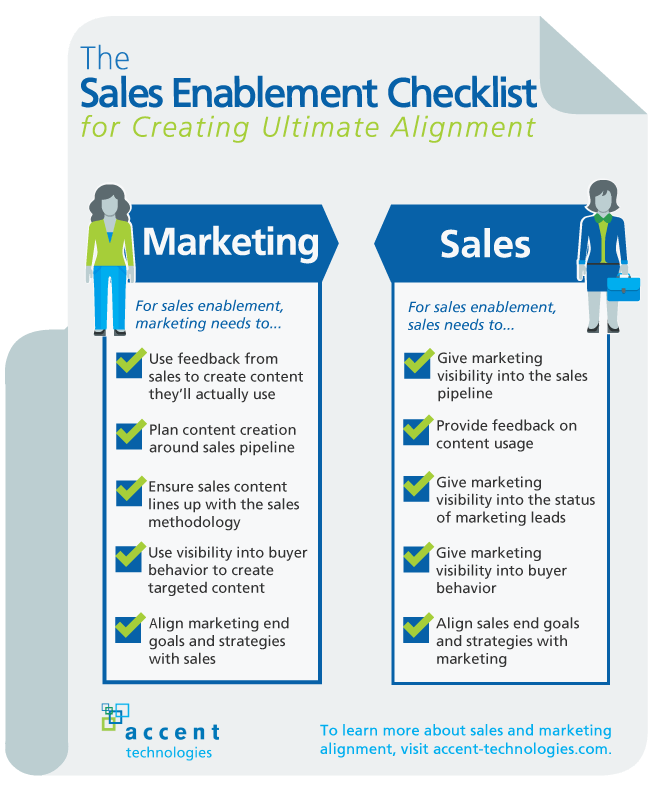There’s a lot of debate about whether sales enablement is the responsibility of the sales team or the marketing team. The truth is, it’s a concentrated effort between both. Marketing provides sales with the resources they need to make sales, like videos, blogs, and other types of content marketing. The sales team then passes this content along to potential customers to lead them through the sales funnel.
What is sales enablement?
HubSpot defines sales enablement as “the iterative process of providing your business’s sales team with the resources they need to close more deals.” The examples HubSpot gives includes content, tools, knowledge, and information to sell your product or service to customers effectively.
Sales enablement doesn’t just consist of marketing assisting sales, though. It’s up to the sales team to relay any relevant information back to marketing about what kind of content works. Sales should also be able to offer up any information about what types of marketing materials are missing from their arsenal. This way, your company’s sales enablement strategy (and web content strategy) never stagnates.
According to CoSchedule, sales enablement focuses on four core elements:
- Sellers having access to the right content at the right time.
- Improved collaboration between marketing and sales.
- Ongoing training to help sales staff deliver on the bottom line.
- Analytics to understand how content resonates with potential customers, then iterating on it for constant improvement.
Read on to learn more about how you can enhance your own B2B company’s sales enablement strategy.
What makes sales enablement effective?
According to LinkedIn, four things must align for your sales enablement strategy to be effective:

Image: LinkedIn
- People: Your sales team has to understand, as well as have documented information on who the ideal client profiles are. Think about your buyer personas! Keep lines of communication open between the sales and marketing teams, ensuring that they’re collaborating. After all, you all have the same end goal. Sirius Decisions found that 19% more growth occurs when businesses align their marketing and sales departments.
- Content: Your content is what your potential buyers see before they have any contact with your sales team. So you want to make sure that content makes them want to move forward in the process. We’ll touch on this more in-depth later on.
- Technology: Segment your client profiles in your CRM, so your sales team can easily distinguish between them. According to HubSpot, 57% of high-performing sales reps say that technology is their top sales enablement priority. Specifically, “deployment of and training on new technology was closely followed by improving rep usage of social media, and restructuring or creating enablement function.”
- Process: Be sure there’s a documented process for what approaches you use during the prospecting process and how often. Continuously reexamine what’s working and what isn’t. Then keep that information in your CRM, accessible to both teams.
Sales enablement for marketers
Many people struggle to determine who “owns” sales enablement. Spoiler alert: nobody does. The entire concept of sales enablement revolves around the collaboration between teams. Sales enablement doesn’t solely fall on the shoulders of the company’s marketers. But, it does mean something a little different than it does for your sales team. In many ways, it’s up to a company’s marketers to even get leads interested in talking to sales. According to the market research firm, Forrester, 60% of B2B buyers get most of their information from sources other than sales reps. You want your marketing materials to be those sources, and you want them to be good enough that they lead buyers to your sales reps.
It’s also a common pain point when the marketing team has loads of useful content that would benefit potential customers, but the sales team just doesn’t know that it exists. Or even where to find it! It seems like a simple enough issue to avoid, but we’re all aware of how bulky and messy workflows can get when they aren’t maintained. Take extra precautions, and keep all of your finished content in a place that each team can easily find.

Image: Accent Technologies
The types of tasks that land on the marketing team to smooth this rocky road include being proactive and using content mapping, providing a smooth transition between the groups, and sharing customer insights. Which brings us to our next point.
Keep an eye on competitive and market insights
Marketers have inside knowledge of the customer’s buying journey before the buyers even get around to speaking to sales. Use that to your advantage and relay that information to sales! This way, your sales team can directly address the things you all know are on your customers’ minds.
What content you’ve created has done well? What pages on your site get the most traffic? If any of your content is lagging, what can you do to make your message clearer and better answer your potential buyers’ questions? Not only can this information aid in the sales enablement process, but it can also help you polish your website strategy.
Don’t minimize the importance of automation
Could everything in your sales strategy be done by hand? Sure, I guess. But why would you take on that burden when there are so many automation tools at your disposal? You don’t want to get bogged down with tedious tasks. HubSpot recommends automating the following:
- Email sequences: An email sequence is a follow-up email automatically triggered when a prospect hasn’t responded within a certain amount of time. They’re completely customizable, from the timeframe that passes before the email sends, to specific details included in the email.
- Prospecting: Why go through the hassle of setting up call times with each prospect when you can let them come to you? In your follow up emails, include a link to your calendar that allows them to schedule time with you. You’ll have a full calendar of qualified leads, without having to lift a finger!
- Direct messaging: Chatbots are nothing new. How you can use them in your sales enablement strategy is. Add filtering criteria to the chatbot on your website, so only quality leads are matched up with sales reps.
You can automate many of these things with sales enablement software, such as HubSpot, Outreach, or Zendesk.

Pay attention to your sales content
Whether we’re talking slide decks, presentations, proposals, or your collateral, all of your sales content needs to be great. And it needs to be used. It might sound silly to have to point this out. However, multiple studies have found that an alarming amount of marketing content is produced and perfected, only for it never to see the light of day. The Content Marketing Institute recently reported that up to 80% of the content provided by marketing teams goes unused. There could be several reasons as to why this happens. Perhaps the content produced is outdated or doesn’t answer the questions prospective buyers have. If that’s the case, that information must be relayed back to the marketing team so that they can re-examine their strategy.
This takes us back, once again, to ensure that both sides have open lines of communication and have easy access to these materials. However, if you’ve taken these precautions and truly find that the content you’re working on ends up being busywork that doesn’t contribute to your bottom line, focus your energy on other aspects of the sales enablement process.




